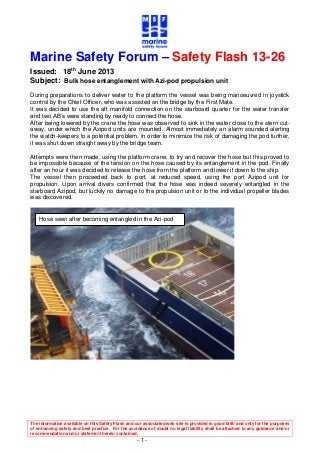
Msf safety-flash-13.26
- 1. The information available on this Safety Flash and our associated web site is provided in good faith and only for the purposes of enhancing safety and best practice. For the avoidance of doubt no legal liability shall be attached to any guidance and/or recommendation and/or statement herein contained. - 1 - Marine Safety Forum – Safety Flash 13-26 Issued: 18th June 2013 Subject: Bulk hose entanglement with Azi-pod propulsion unit During preparations to deliver water to the platform the vessel was being manoeuvred in joystick control by the Chief Officer, who was assisted on the bridge by the First Mate. It was decided to use the aft manifold connection on the starboard quarter for the water transfer and two AB’s were standing by ready to connect the hose. After being lowered by the crane the hose was observed to sink in the water close to the stern cut- away, under which the Azipod units are mounted. Almost immediately an alarm sounded alerting the watch-keepers to a potential problem. In order to minimize the risk of damaging the pod further, it was shut down straight away by the bridge team. Attempts were then made, using the platform crane, to try and recover the hose but this proved to be impossible because of the tension on the hose caused by its entanglement in the pod. Finally after an hour it was decided to release the hose from the platform and lower it down to the ship. The vessel then proceeded back to port, at reduced speed, using the port Azipod unit for propulsion. Upon arrival divers confirmed that the hose was indeed severely entangled in the starboard Azipod, but luckily no damage to the propulsion unit or to the individual propeller blades was discovered. Hose seen after becoming entangled in the Azi-pod
- 2. The information available on this Safety Flash and our associated web site is provided in good faith and only for the purposes of enhancing safety and best practice. For the avoidance of doubt no legal liability shall be attached to any guidance and/or recommendation and/or statement herein contained. - 2 - Significant Factors include; Learning’s / recommended action(s): 1) Use of aft manifold connections to be fully risk assessed for similar operations where potential for hoses to be drawn into propulsion units is higher. 2) Vessel to be positioned further from offshore installation where possible. 3) Offshore personnel advised to ensure that bulk hoses are inspected regularly and that they meet the requirements of the NWEA guidelines, especially with regards to floatation collars. 4) Consideration to be given to arrangements such as weak links to minimise the potential for further damage due to increased difficulty in releasing the hose. The vessels close proximity to the platform (15m-18m), probably allowing a bight of hose to develop on the surface The decision to use the aft manifold connection instead of mid-ships for the hose transfer The lightly laden deck resulted in the stern cut-away being closer to the surface presenting a greater opportunity for hoses to come into contact with propulsion units
